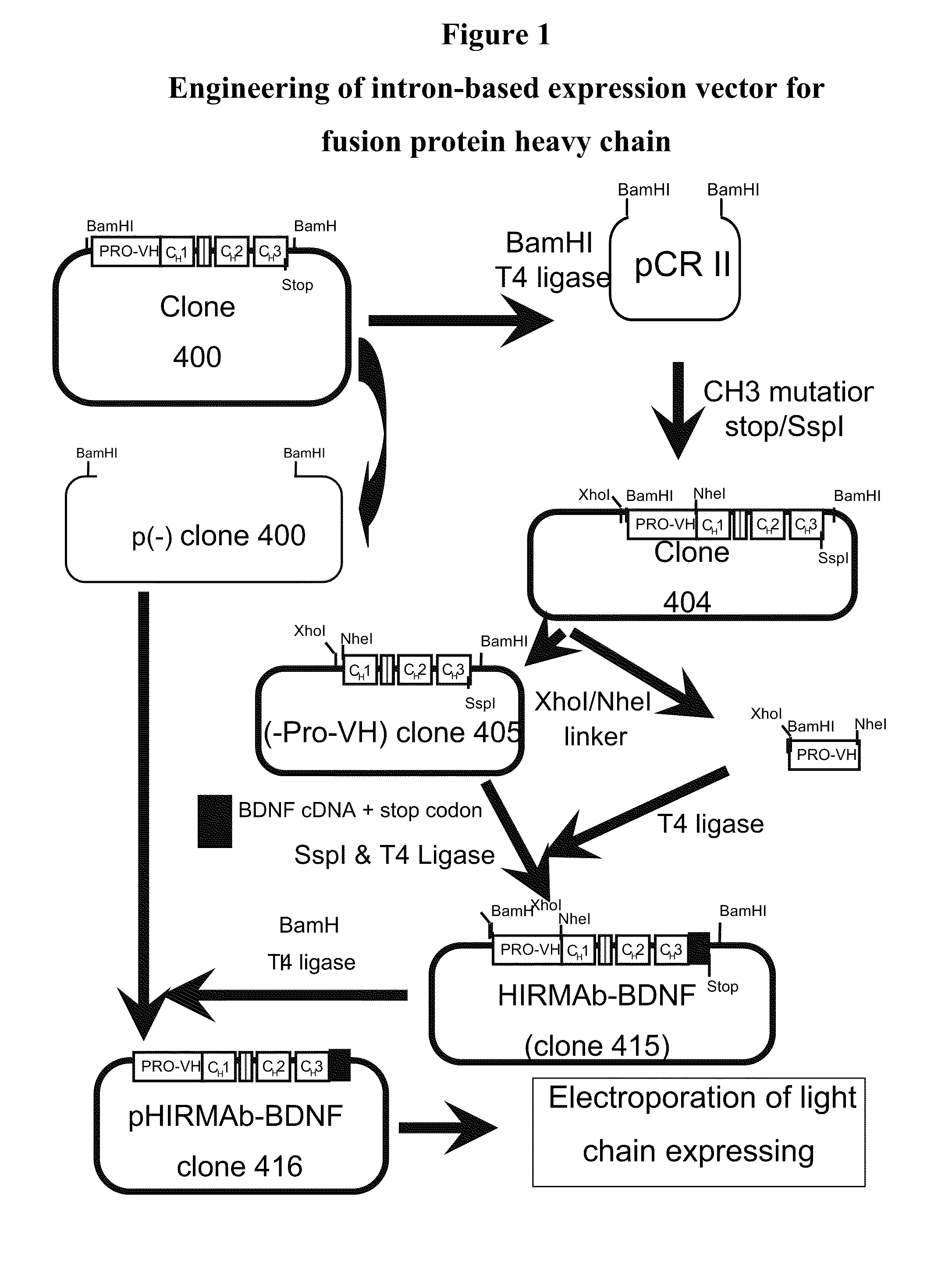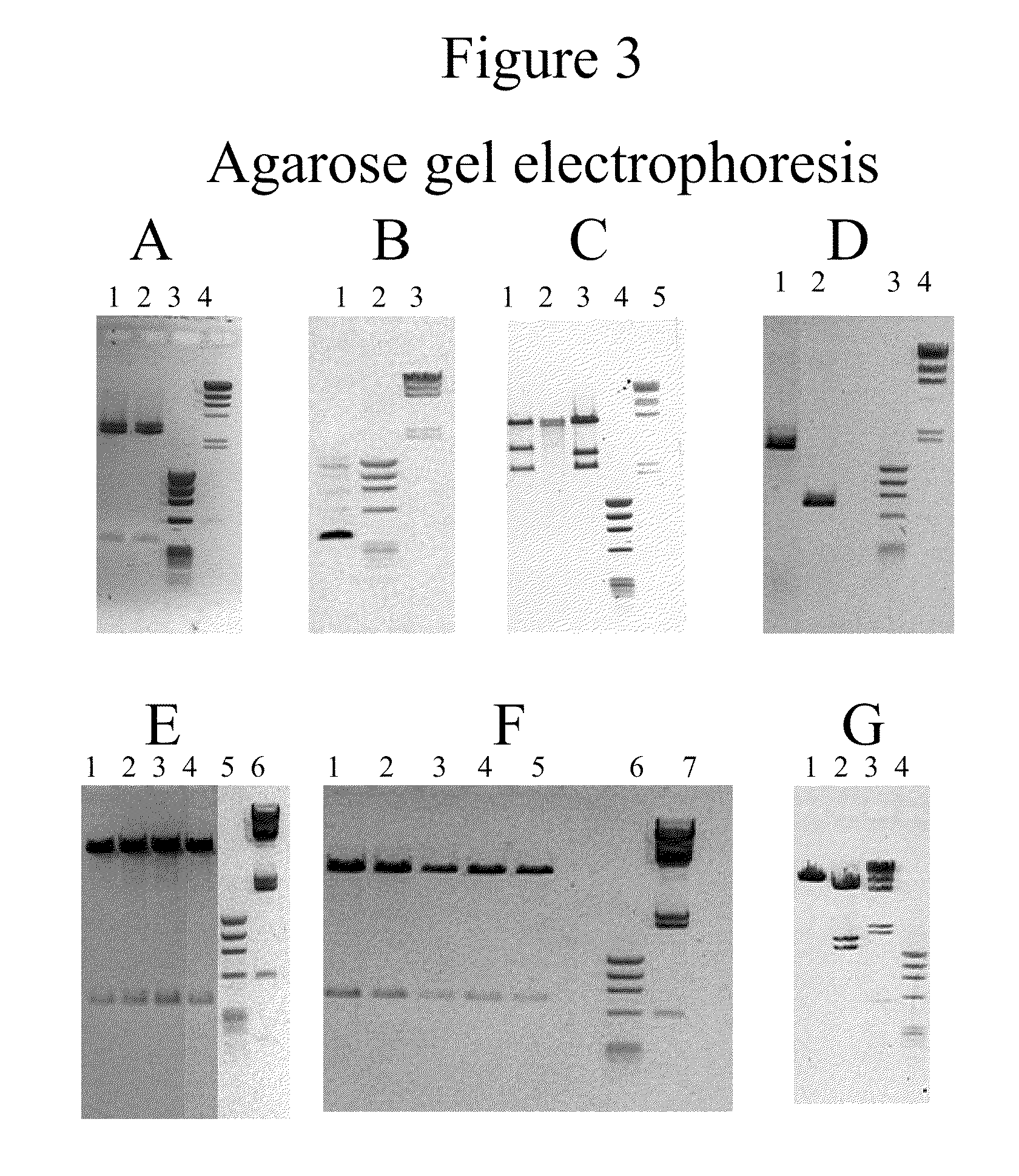Fusion proteins for delivery of erythropoietin to the CNS
a technology of erythropoietin and fusion proteins, which is applied in the direction of extracellular fluid disorder, antibody medical ingredients, metabolic disorders, etc., can solve the problems of inability to exert a therapeutic effect in many neurological disorders or other conditions, current treatment options are limited in some aspects, and neurologic disorders are a major cause of mortality and disability worldwid
- Summary
- Abstract
- Description
- Claims
- Application Information
AI Technical Summary
Benefits of technology
Problems solved by technology
Method used
Image
Examples
example 1
Construction of the Single Tandem Vector Containing Complete Genes for IgG-Neurotherapeutic Fusion
[0298]Genetic engineering of a eukaryotic expression vector encoding the heavy chain (HC) of the fusion protein is outlined in FIG. 1. The final fusion protein HC expression vector was designated pHIRMAb-BDNF, or clone 416. This vector was designed to produce a fusion protein, comprised of a BDNF variant fused to the HC of the HIRMAb. Either BDNF or a variant of BDNF (vBDNF) can be fused to the HIRMAb. The vBDNF differs from native human BDNF by substitution of certain amino acids, such as a vBDNF where the 2 amino acids at the carboxyl terminus of BDNF are absent in vBDNF. The clone 416 plasmid was derived from clone 400, which produces the HC of the chimeric form of the HIRMAb, and a cDNA encoding mature human vBDNF, which was produced as described in FIG. 2. Clone 400 encodes a chimeric human IgG1 that is derived from a chromosomal fragment encoding the human IgG1 constant region, an...
example 2
Electroporation of CHO Cells with Fusion Protein Tandem Vector and Cultivation in a Bioreactor
[0320]The fusion protein tandem vector (FIG. 12) was linearized with PvuI and electroporated into CHO-K1 cells followed by selection with G418 (375 ug / ml) for 3 weeks. Positive clones were detected in 96 well plates with a human IgG ELISA that uses 2 primary antibodies to both the human IgG1 HC and the human kappa LC. Cell lines of high copy number of the transgene were selected by graded increases in MTX to 600 nM. The MTX-selected cell line was grown in T175 flasks and then transferred to a 20 L bioreactor with a 10 L volume of CHO cell serum free medium (SFM). As shown in FIG. 17, the CHO cells were maintained at high density in excess of 10 million viable cells / mL for nearly 50 days in perfusion mode in the bioreactor. The secretion by these cells of the fusion protein was detected by ELISA using antibodies to either human IgG or to human BDNF. As shown in FIG. 18, the fusion protein is...
example 3
Purification and Characterization of Bioreactor Produced Fusion Protein
[0321]The conditioned medium obtained from the bioreactor under perfusion mode was passed through a 1 μm filter, and the medium collected in a 200 L Bioprocess container under sterile conditions, which were maintained at 4° C. in a glass door refrigerator contiguous with the bioreactor. Then, 200 L batches of conditioned medium were passed through 1 μm and 0.4 μm pre-filters for the removal of cell debris. The medium was then concentrated with tangential flow filtration (TFF). The TFF system was a Pellicon 2 model from Millipore and was comprised of five 0.5 m2 filtration cassettes with a 30 kDa molecular weight cutoff and a total surface area of 2.5 m2. A transmembrane gradient of 15 PSI was produced, which results in a reduction in volume of the 200 L to 2 L within 2 hours. The concentrated medium was passed through an 0.22μ filter prior to elution through 100 mL Prosep A (Millipore) recombinant protein A affin...
PUM
| Property | Measurement | Unit |
|---|---|---|
| Fraction | aaaaa | aaaaa |
| Mass | aaaaa | aaaaa |
| Mass | aaaaa | aaaaa |
Abstract
Description
Claims
Application Information
 Login to View More
Login to View More - R&D
- Intellectual Property
- Life Sciences
- Materials
- Tech Scout
- Unparalleled Data Quality
- Higher Quality Content
- 60% Fewer Hallucinations
Browse by: Latest US Patents, China's latest patents, Technical Efficacy Thesaurus, Application Domain, Technology Topic, Popular Technical Reports.
© 2025 PatSnap. All rights reserved.Legal|Privacy policy|Modern Slavery Act Transparency Statement|Sitemap|About US| Contact US: help@patsnap.com



